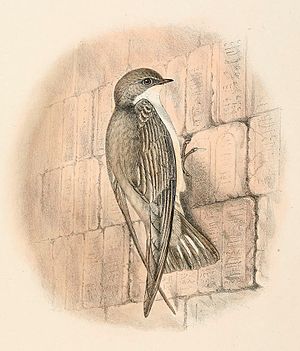Wikipedia:Wikipedia Signpost/2012-12-17/Featured content
Appearance
Featured content
Wikipedia's cute ass
This edition covers content promoted between 9 and 15 December 2012.

Featured articles


Four featured articles were promoted this week:
- Pale Crag Martin (nom) by Jimfbleak. The Pale Crag Martin (Ptyonoprogne obsoleta) is a 12–13 cm (4.7–5.1 in) long bird in the swallow family that is resident to parts of Africa and Asia. It tends to breed in mountains, far from water, but is often seen near human settlements. It constructs its nest with mud pellets, forming a deep bowl on sheltered horizontal surfaces, or a neat quarter-sphere against a vertical faces. It is assessed as Least Concern on the IUCN Red List owing to its large range and population.
- Banksia aquilonia (nom) by Casliber. B. aquilonia, known as the northern banksia, is a tree native to wet sclerophyll forest and rainforest margins on sandy soils in Queensland, Australia. It grows to an average height of 8 m (26 ft) and has narrow glossy green leaves, with high pale yellow flower spikes appearing in autumn. The plant was described in 1981 as a variety of B. integrifolia, but later reclassified. It is rarely cultivated.
- Joseph Grimaldi (nom) by Cassianto. Grimaldi (1778–1837) was the most popular English entertainer of the Regency era. An actor, comedian and dancer, he was best known as a Clown; the nickname "Joey", Grimaldi's whiteface make-up design, and his catchphrase "Here we are again!" remain in use. Grimaldi took his first major role at the age of three, becoming a star by the late 1790s. He took his most famous role, in Harlequin or Mother Goose, in 1806. He continued to act until his retirement in 1823.
- Strepsirrhini (nom) by Maky. Strepsirrhini is a suborder of primates which consist of the lemurs, galagos, pottos, and lorises; an extinct group has also been classified in Strepsirrhini. They are defined by their wet noses, but have traits such as producing their own vitamin C and a smaller brain than comparably sized simians. The suborder's taxonomy is controversial and has a complicated history. Many strepsirrhines are endangered because of human activities.
Featured lists
Three featured lists were promoted this week:
- Grade I listed churches in Lancashire (nom) by Peter I. Vardy. The English county of Lancashire is home to 25 churches which have been given a Grade I listing, designating them of "exceptional interest, sometimes considered to be internationally important".
- Latin Grammy Award for Best Short Form Music Video (nom) by Jaespinoza. The Latin Grammy Award for Best Short Form Music Video has been presented annually to directors and producers of a music video released in the the award eligibility year since 2000.
- List of The Office (UK TV series) episodes (nom) by User:Ajmint. The British sitcom The Office saw fourteen episodes during its 2001–2003 run, spanning two seasons and two Christmas specials.
Featured pictures
Five featured pictures were promoted this week:
- John Day Formation (nom; related article), created by Finetooth and nominated by Tomer T. The John Day Formation is a series of rock strata exposed in north-central Oregon, US. It was mainly formed from volcanic ashfalls.
- Gift for the Grangers (nom; related article), created by Strobridge & Co., restored by Trialsanderrors, and nominated by Tomer T. The Grange is an American fraternal organization and the oldest American agricultural advocacy group with a national scope. The featured image is an advertisement for the group.
- Ambleside (nom; related article), created by Diliff and nominated by Tomer T. Ambleside is a town in North West England. Situated near the country's largest lake and with a history dating back almost two millennia, it is home to 2,600 people.
- Loughrigg Tarn (nom; related article), created by Diliff and nominated by Tomer T. Loughrigg Tarn is a small, natural lake north of Windermere in England. It was a favoured place of William Wordsworth.
- Young Donkey (nom; related article), created by Lilly M and nominated by Tomer T. The donkey (Equus africanus asinus) is a domesticated member of the horse family. The subject of the new featured picture is three weeks old.




Discuss this story